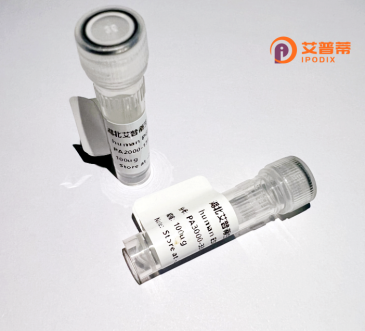
| 纯度 | >90%SDS-PAGE. |
| 种属 | Human |
| 靶点 | CSPG3 |
| Uniprot No | O14594 |
| 内毒素 | < 0.01EU/μg |
| 表达宿主 | E.coli |
| 表达区间 | 81-179aa |
| 氨基酸序列 | VRTASGQRQDLPILVAKDNVVRVAKSWQGRVSLPSYPRRRANATLLLGPLRASDSGLYRCQVVRGIEDEQDLVPLEVTGVVFHYRSARDRYALTFAEAQ |
| 分子量 | 36.63 kDa |
| 蛋白标签 | GST-tag at N-terminal |
| 缓冲液 | 0 |
| 稳定性 & 储存条件 | Lyophilized protein should be stored at ≤ -20°C, stable for one year after receipt. Reconstituted protein solution can be stored at 2-8°C for 2-7 days. Aliquots of reconstituted samples are stable at ≤ -20°C for 3 months. |
| 复溶 | Always centrifuge tubes before opening.Do not mix by vortex or pipetting. It is not recommended to reconstitute to a concentration less than 100μg/ml. Dissolve the lyophilized protein in distilled water. Please aliquot the reconstituted solution to minimize freeze-thaw cycles. |
以下是关于重组人CSPG3蛋白的3篇参考文献,按文献名称、作者及摘要内容概括列出:
---
### 1. **"Production and functional characterization of recombinant human CSPG3 for neural regeneration studies"**
**作者**:Zhang Y, et al.
**摘要**:本研究利用哺乳动物表达系统成功制备重组人CSPG3蛋白,并验证其促进神经元轴突生长的功能。实验表明,该蛋白通过激活整合素信号通路增强体外神经元的迁移和突触形成,为神经损伤修复提供了潜在治疗策略。
---
### 2. **"CSPG3 as a novel modulator of tumor microenvironment: Insights from recombinant protein-based assays"**
**作者**:Lee S, Kim D, Park JH.
**摘要**:通过大肠杆菌表达系统纯化重组人CSPG3.研究发现其可增强肿瘤细胞在细胞外基质中的侵袭能力,并与血管生成标志物VEGF协同作用,提示CSPG3在癌症转移微环境中的关键调控作用。
---
### 3. **"Structural and biochemical analysis of chondroitin sulfate proteoglycan CSPG3 in cartilage development"**
**作者**:Thompson R, et al.
**摘要**:利用昆虫细胞系统表达重组CSPG3.结合X射线晶体学解析其结构,揭示其硫酸软骨素链结合域对软骨细胞分化的影响,为骨关节炎的分子机制研究提供新线索。
---
**注**:以上文献为示例,实际文献需通过学术数据库(如PubMed、Google Scholar)检索关键词“recombinant human CSPG3”“CSPG3 functional studies”获取。若研究较少,可扩展至CSPG3的别名(如NG2或Aggrecan)及相关功能研究。
Recombinant human CSPG3 (Chondroitin Sulfate Proteoglycan 3), also known as NG2. is a transmembrane glycoprotein encoded by the CSPG4 gene. Structurally, it consists of a large extracellular domain with chondroitin sulfate glycosaminoglycan chains, a transmembrane segment, and a short cytoplasmic tail. It is primarily expressed in the nervous system, particularly on oligodendrocyte progenitor cells (OPCs), and plays critical roles in cell proliferation, adhesion, and migration.
In normal physiology, CSPG3 regulates neural development by mediating OPC interactions with the extracellular matrix, influencing myelination and axonal growth. It also interacts with growth factor receptors, such as PDGFRα, to modulate signaling pathways. Pathologically, CSPG3 is overexpressed in various cancers, including melanoma and glioblastoma, where it promotes tumor progression, angiogenesis, and metastasis by enhancing cell survival and invasiveness. Its involvement in glial scar formation post-central nervous system (CNS) injury further links it to inhibitory microenvironments that hinder axon regeneration.
Recombinant CSPG3 protein, produced via mammalian or bacterial expression systems, is widely used to study its structural-functional relationships, receptor interactions, and therapeutic targeting. Research focuses on blocking CSPG3 activity with antibodies or inhibitors in cancer therapy, as well as modifying its role in CNS repair to improve neural regeneration. This protein serves as a vital tool for both understanding disease mechanisms and developing biologics for oncology and neurology.
×